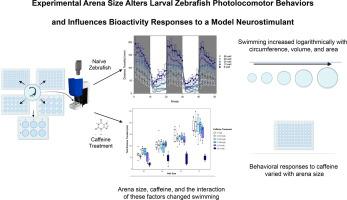Environment International ( IF 10.3 ) Pub Date : 2023-06-01 , DOI: 10.1016/j.envint.2023.107995 Lea M Lovin 1 , Kendall R Scarlett 1 , Abigail N Henke 2 , Jaylen L Sims 1 , Bryan W Brooks 1

|
Zebrafish behavior is increasingly common in biomedical and environmental studies of chemical bioactivity. Multiple experimental arena sizes have been used to measure photolocomotion in zebrafish depending on age, endpoints observed, and instrumentation, among other factors. However, the extent to which methodological parameters may influence naïve behavioral performance and detection of behavioral changes is poorly understood. Here we measured photolocomotion and behavioral profiles of naïve larval zebrafish across arena sizes. We then performed concentration response studies with the model neurostimulant caffeine, again across various arena dimensions. We found total swimming distance of unexposed fish to increase logarithmically with arena size related similarly to circumference, area, and volume. Photomotor response during light/dark transitions also increased with arena size. In caffeine exposed fish, total distance travelled was significantly (p < 0.001) affected by well size, caffeine treatment (p < 0.001), and the interaction of the two experimental factors (p < 0.001). In addition, behavioral response profiles showed differences between 96 well plates and larger sizes. Biphasic response, with stimulation at lower concentrations and refraction at the highest concentration, was observed in dark conditions in the 96 well size only, though almost no effects were identified in the light. However, swimming behavior was significantly (p < 0.1) altered in the highest studied caffeine treatment level in larger well sizes during both light and dark periods. Our results indicate zebrafish swim more in larger arenas and arena size influences behavioral response profiles to caffeine, though differences are mostly between very small and large arenas. Further, careful consideration should be given when choosing arena size, because small wells may lead to restriction, while larger wells may differentially reflect biologically relevant effects. These findings can improve comparability among experimental designs and demonstrates the importance of understanding confounding methodological variables.
中文翻译:

实验竞技场大小改变斑马鱼幼虫的光运动行为并影响对模型神经刺激剂的生物活性反应
斑马鱼的行为在化学生物活性的生物医学和环境研究中越来越常见。根据年龄、观察到的终点和仪器等因素,使用多个实验场地大小来测量斑马鱼的光运动。然而,人们对方法参数可能在多大程度上影响幼稚行为表现和行为变化检测的程度知之甚少。在这里,我们测量了斑马鱼幼虫在不同大小的竞技场中的光运动和行为特征。然后,我们使用模型神经刺激剂咖啡因进行了浓度反应研究,同样是在不同的领域维度上进行的。我们发现,未暴露的鱼的总游泳距离随着与周长、面积和体积类似的竞技场大小呈对数增加。明/暗转换期间的光运动响应也随着场地大小的增加而增加。在接触咖啡因的鱼中,总游动距离显着 (p < 0.001) 受到孔大小、咖啡因处理 (p < 0.001) 以及两个实验因素的相互作用 (p < 0.001) 的影响。此外,行为反应概况显示 96 孔板和更大尺寸的板之间存在差异。仅在 96 孔尺寸的黑暗条件下观察到双相反应,即较低浓度的刺激和最高浓度的折射,但在光下几乎没有发现任何影响。然而,在较大的孔尺寸中,在光照和黑暗时期,在最高研究的咖啡因处理水平下,游泳行为显着改变(p < 0.1)。我们的结果表明,斑马鱼在较大的竞技场中游泳更多,并且竞技场的大小会影响对咖啡因的行为反应,尽管差异主要存在于非常小的和大型的竞技场之间。此外,在选择竞技场大小时应仔细考虑,因为小孔可能会导致限制,而较大的孔可能会不同地反映生物学相关的影响。这些发现可以提高实验设计之间的可比性,并证明理解混杂方法变量的重要性。











































 京公网安备 11010802027423号
京公网安备 11010802027423号